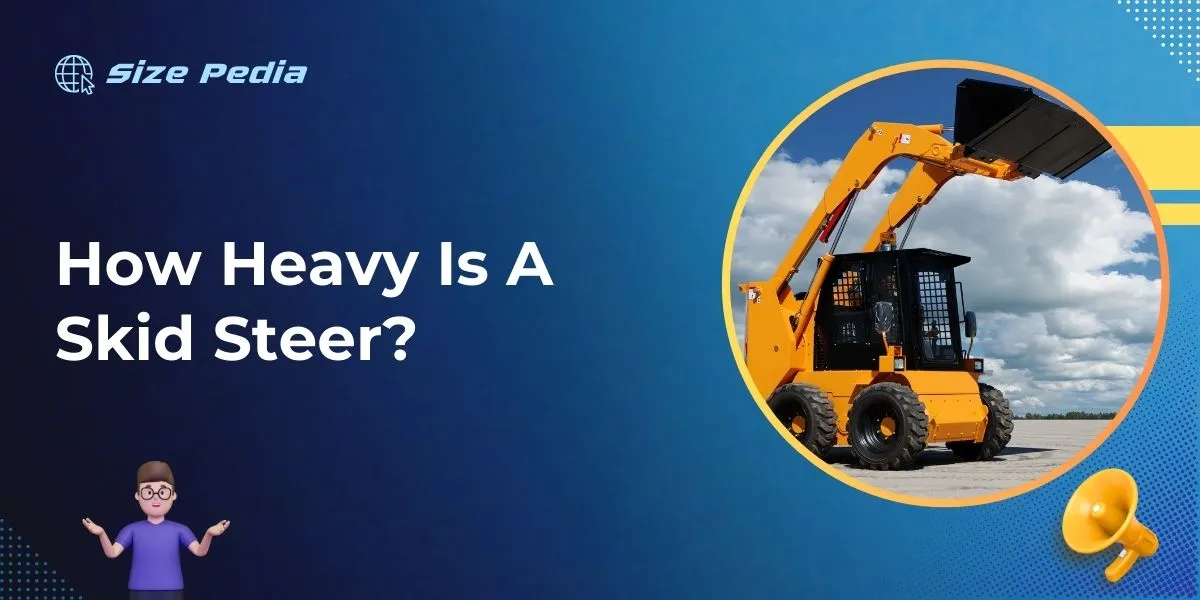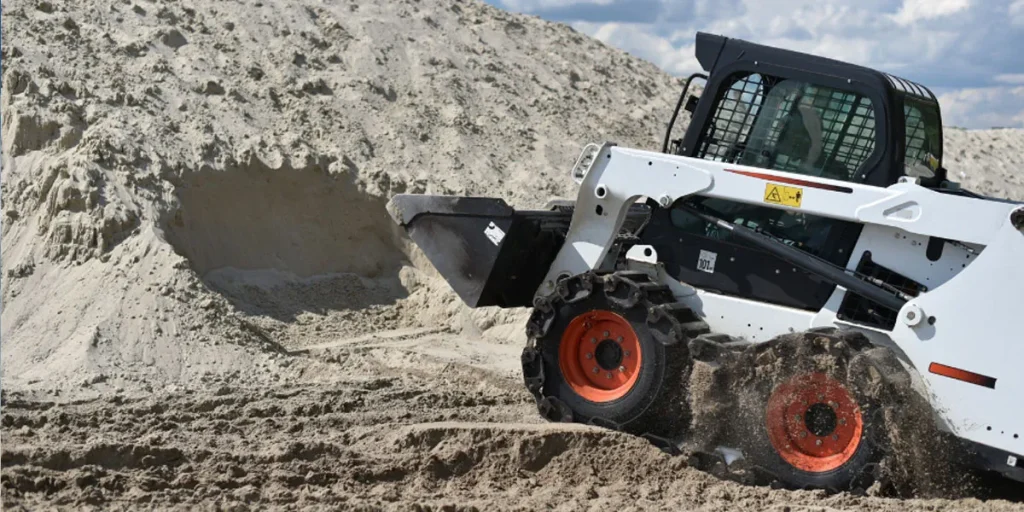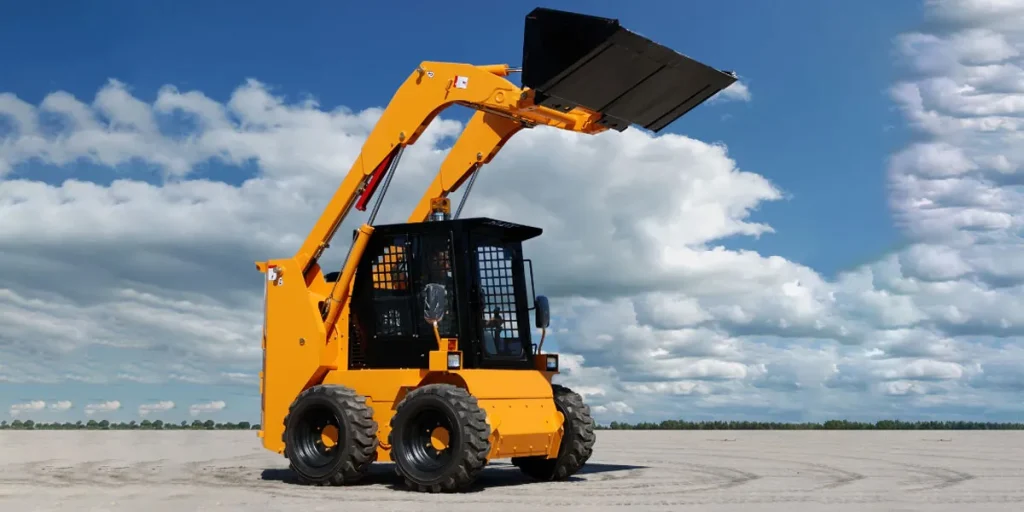A skid steer’s weight ranges from 1,500 to 12,000 pounds. The model and specifications greatly influence the exact weight.
Skid steer loaders are pivotal in construction, landscaping, and farming due to their versatility and compact size.
Different models cater to various tasks with attachments like buckets, hammers, or augers, thus affecting their weight.
Compact models usually tip the scales at a lighter weight, ideal for residential projects and confined spaces.
Conversely, large-scale operations demand heavier and more robust skid steers, which bring greater lifting capability and stability.
Regardless of size, their maneuverability and ability to turn within their footprint make them indispensable in tight quarters.
Understanding a skid steer’s weight is crucial for safe transportation, operation, and determining the suitability for certain tasks or terrain.

Weight Spectrum Of Skid Steers
Skid steers vary greatly in weight. This variation depends on the model, size, and attachments used.
They can weigh as little as 1,500 pounds to over 12,000 pounds. Understanding the weight spectrum is essential for job matching and transport logistics.
Factors Influencing Weight
Several factors contribute to the weight of a skid steer:
- Model and Size: Larger models weigh more.
- Engine Type: Diesel engines typically add weight.
- Attachments: Tools like augers or backhoes increase weight.
- Materials: Steel components contribute significantly to overall weight.
Comparing Light And Heavy Models
Light skid steers are easier to transport and maneuver in tight spaces. They typically weigh between 1,500 to 5,000 pounds.
Heavy models, weighing 6,000 to 12,000 pounds, handle tougher jobs. They offer more power and capacity.
| Skid Steer Type | Typical Weight Range |
|---|---|
| Light Models | 1,500 – 5,000 lbs |
| Heavy Models | 6,000 – 12,000 lbs |
Exploring Skid Steer Capacities

Understanding a skid steer’s capabilities is key when choosing the right equipment for your job. Skid steers are powerful machines.
They vary in weight and size. Each model has a specific operating capacity. Their tipping load is also important. Let’s dive deep into the world of skid steer capacities.
Operating Capacity Vs. Tipping Load
These terms are often confused, but they are quite different.
- Operating capacity is the max weight a skid steer can safely carry. It is around 50% of the tipping load.
- Tipping load refers to when the machine starts to tip over. It is a safety limit.
Knowing these helps you work safely and efficiently.
Metric Tonnage Breakdown
| Skid Steer Size | Operating Capacity (kg) | Tipping Load (kg) |
|---|---|---|
| Small | Up to 680 | Up to 1360 |
| Medium | 680 – 1,360 | 1360 – 2720 |
| Large | Over 1,360 | Over 2720 |
Each size range comes with its advantages. Small skid steers are agile. Large ones handle more weight.
Compact To Full-sized Skid Steers
Imagine having a superhero in your toolbox. In the world of construction, skid steers are just that. From lifting heaps of earth to clearing debris, these powerhouses come in varied sizes.
Whether they’re compact or full-sized, the might they bring to a job site is undeniable. But with different sizes, come different weights.
Let’s dive into the fascinating world of skid steers and understand how their size influences their mass and capabilities.
Dimensions And Corresponding Weight
Skid steers are not one-size-fits-all. A compact skid steer might weigh as little as 2,500 pounds, while a full-sized beast could tip the scales at over 9,000 pounds.
Different tasks call for different sizes. A smaller unit is easier to transport and nimbler in tight spaces.
A larger one carries more weight and power through significant tasks. Check out the typical dimensions and weights:
| Skid Steer Size | Weight Range | Width | Height | Length (without attachment) |
|---|---|---|---|---|
| Compact | 2,500 – 4,000 lbs | 3 – 4 ft | 6 – 7 ft | 8 – 9 ft |
| Medium | 4,000 – 6,000 lbs | 4 – 5 ft | 7 – 8 ft | 9 – 11 ft |
| Full-sized | 6,000 – 9,000+ lbs | 5 – 6+ ft | 8 – 9+ ft | 11 – 13+ ft |
Impact Of Size On Performance
Size impacts how a skid steer performs. Choosing the right size for your project is like picking the right key for a lock.
Compact skid steers are great for jobs in confined spaces. They have lower operating weight and are easier on surfaces. On the flip side, full-sized skid steers are heavy hitters.
They excel in open areas where their power and size are advantages. With more weight, they offer higher lifting capacity and can tackle tougher jobs. Here’s how the size impacts performance:
- Compact Skid Steers:
- Maneuver tight spaces easily.
- Less ground disturbance.
- Perfect for landscaping and interior demolition.
- Full-sized Skid Steers:
- Higher lifting capacities.
- Better for grading and excavating large areas.
- Fit for demanding tasks like road construction.
Attachments Add Up

When exploring the capabilities of a skid steer, it’s clear that versatility is its superpower. This machine turns into a multitasking hero with the right attachments.
Each add-on, however, means more weight. Understanding how these attachments tip the scales is crucial for safe and efficient operation.
Common Skid Steer Attachments
Skid steer loaders come to life with an array of attachments. Here are some favorites:
- Bucket: Ideal for digging, loading, and carrying.
- Forks: Perfect for pallet and material handling.
- Auger: Useful for drilling holes for fences and trees.
- Hammer: Breaks up concrete with powerful strikes.
- Snowblade: Clears snow efficiently.
- Grapple: For gripping and moving hard-to-handle materials.
How Attachments Affect The Overall Weight?
Attachments transform functional capacity. Yet, they also bring additional heft. Below, see how common attachments contribute to a skid steer’s weight:
| Attachment | Average Weight (lbs) |
|---|---|
| Bucket | 700-800 |
| Forks | 400-600 |
| Auger | 500-750 |
| Hammer | 800-1200 |
| Snowblade | 350-500 |
| Grapple | 600-1400 |
Each attachment affects the skid steer’s balance and performance. Heavier attachments demand more power and might restrict maneuverability.
Operators should always check the combined weight to maintain safety guidelines. Plan and pair the skid steer with the correct attachment to ensure optimal performance.
Real-world Applications And Weight Considerations
Understanding the weight of a skid steer is crucial for its operation and transportation.
Finding the sweet spot between lifting capacity and operational efficiency forms the foundation for successful real-world applications.
In various industries, from construction to agriculture, knowing a skid steer’s weight influences many aspects of project planning and execution.
Transportation And Hauling Challenges
Moving a skid steer from site to site demands careful consideration. Transport vehicles and trailers must support the skid steer’s weight.
This often includes the machine’s base weight plus any attachments. Below is a brief overview of common skid steer weights:
| Skid Steer Type | Average Weight |
|---|---|
| Small Frame | 1,750 to 2,200 lbs |
| Medium Frame | 2,200 to 3,000 lbs |
| Large Frame | 3,000 to 4,500 lbs |
Staying informed about trailer capacity and weight regulations ensures safe and legal transport. Operators must also account for potential road weight limits.
Site Restrictions And Weight Limitations
Each job site has unique weight restrictions to consider. Ground pressure is a concern, especially on delicate surfaces or in areas with buried utilities.
The following points highlight key considerations:
- Overhead capacity: Check the load-bearing abilities of bridges and overpasses.
- Surface damage: Minimize the impact on pavements, lawns, and indoor flooring.
- Environmental impact: Follow regulations to protect ecosystems and heritage sites.
Selecting the right skid steer involves balancing its weight with the limitations of the work environment. This ensures efficiency and safety across various operational scenarios.
Frequently Asked Questions On How Heavy Is A Skid Steer
What Is The Average Weight Of A Skid Steer?
A typical skid steer weighs between 6,000 to 10,000 pounds. However, compact models can be lighter, starting around 3,000 pounds, while larger models can exceed 12,000 pounds. Weight varies by brand and capacity.
How Does A Skid Steer’s Weight Affect Performance?
The weight of a skid steer influences stability and lifting capacity. Heavier skid steers can handle more weight and are more stable when lifting heavy loads. Conversely, lighter models are easier to transport and maneuver in tight spaces.
Can Skid Steer Weight Impact Transportation Requirements?
Yes, the weight of a skid steer affects transportation needs. Heavier skid steers might require specialized trailers and may need to comply with specific transportation regulations due to their weight class.
What Factors Contribute To The Weight Of A Skid Steer?
Skid steer weight is affected by its size, engine type, materials, and additional features like enclosed cabins or high-flow hydraulics. Attachments also add to the overall operating weight.
Conclusion
Understanding a skid steer’s weight is vital for safe operation and transport. Weight varies, from 2,500 to over 9,000 pounds, depending on model and attachments.
For optimal performance and safety, always refer to the manufacturer’s specs and heed the job site’s weight restrictions.
Your thorough knowledge ensures efficiency and prevents undue strain on equipment.
Resources:
https://extension.psu.edu/skid-steer-safety-for-farm-and-landscape
https://www.ehs.ucsb.edu/programs-services/industrial-safety/skid-steer-loader-tractor-safety
